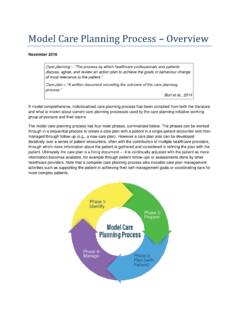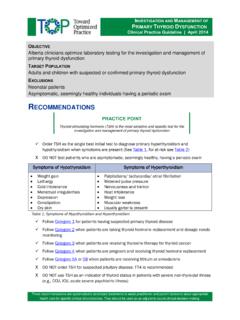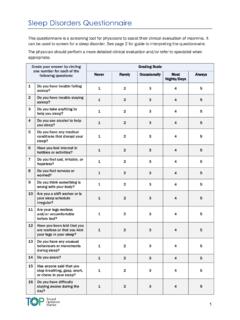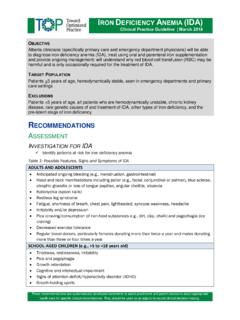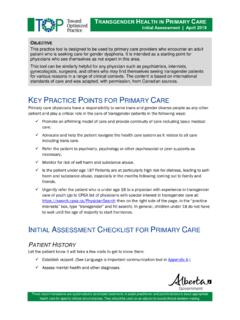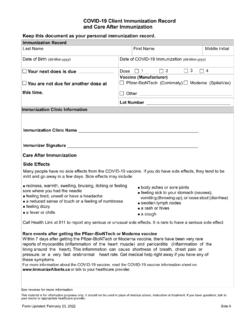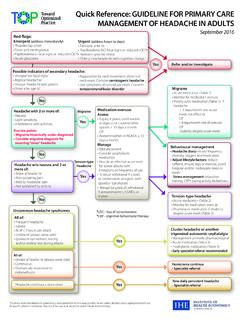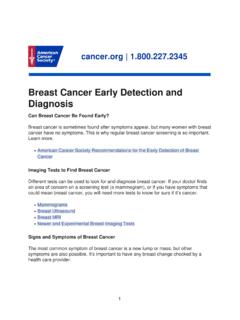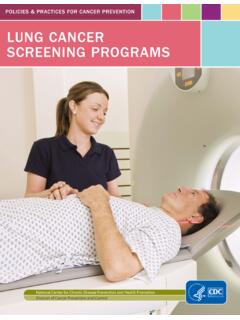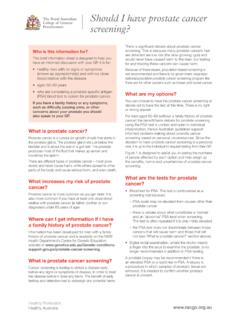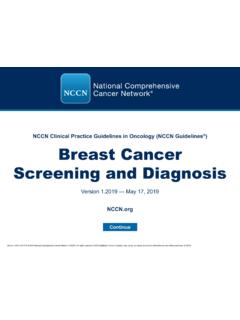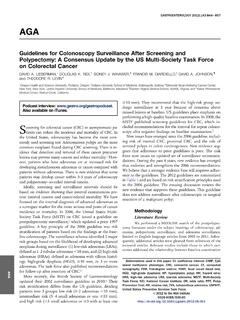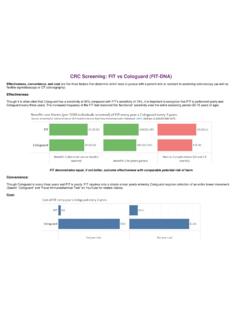Transcription of Cervical Cancer Screening - Alberta Doctors
1 Cervical Cancer Screening Clinical Practice Guideline | May 2016 These recommendations are systematically developed statements to assist practitioner and patient decisions about appropriate health care for specific clinical circumstances. They should be used as an adjunct to sound clinical decision making. OBJECTIVE Alberta clinicians will understand the recent evidence, offer age and risk-appropriate Cervical Cancer Screening , and follow up on abnormal screen results. TARGET POPULATION Consider all women 21-69 years of age who are or have ever been sexually active. Include transgender people with a cervix.
2 EXCLUSIONS Women who have never been sexually active Women with symptoms such as vaginal spotting or bleeding need investigation but not Screening RECOMMENDATIONS SCREEN Asymptomatic average risk women who are or have ever been sexually active* (see Table 1) Start after three years from onset of sexual activity* or age 25, whichever is later. *Sexual activity includes intercourse as well as digital or oral sexual activity involving the genital area with a partner of any gender. Age Range 21-24 25-29 30-69 >70 Screen ? Optional Screening Initiate routine Screening Routine Screening Screen If unscreened/under-screened ( , not screened regularly at three year intervals) Interval Every three years Every three years Every three years Until three consecutive negative Pap tests (collected at least one year apart) within 10 years Evidence Harm is likely greater than benefit (moderate evidence) Benefit is likely greater than harm (moderate evidence) Benefit is likely greater than harm (strong evidence) Less evidence, but biologically plausible that the risk of disease is high/continues.
3 Screening may reduce morbidity and mortality. Table 1: Cervical Cancer Screening Algorithm PRACTICE POINT Regular Screening should be emphasized for women 25-69 and older (if under/unscreened), but all women 21 and older should be given a choice. The decision to start or stop Screening should be an individual one. Women who place a higher value on the potential benefit than the potential harms may choose to begin Screening between the ages of 21-24 and some women may choose to continue with Screening beyond the age of 69. To assist with the discussion and patient decision-making see the FAQ resource. Cervical Cancer Screening | May 2016 Clinical Practice Guideline Page 2 of 20 Recommendations DO NOT SCREEN WOMEN X Less than 21 years of age X Greater than or 70 years of age who have been adequately screened and choose to stop Screening X With a limited life expectancy and no benefit from Screening X With a total hysterectomy for benign disease with no Cervical abnormalities X Who have never been sexually active PRACTICE POINT A Papanicolaou (Pap) test is a Screening test for use in an asymptomatic population with no apparent signs of neoplasia.
4 If the woman is symptomatic she should be investigated regardless of age. See Abnormal Uterine Bleeding in Pre-Menopausal Women CONSIDERATIONS FOR Screening PREGNANT WOMEN Screen pregnant women according to the recommendations for Screening non-pregnant women. X DO NOT repeat the Pap test until six months post-partum if ASC-US or LSIL is detected during pregnancy. All other findings, especially more advanced lesions, should be managed according to Management of Abnormal Pap Test Results. X DO NOT over-screen. There is no need to perform Pap test during pre-natal and post-partum visits unless the woman is otherwise due for Screening .
5 CHECKLIST FOR PROVIDING OPTIMAL PAP TESTING See Appendix A. KEY MESSAGES TO GUIDE PERSONAL DECISION-MAKING See Appendix B. OFFER ADDIT IONAL Screening INFORMATION Refer women to the following resources** available from the Alberta Cervical Cancer Screening Program (ACCSP): o Cervical Screening : Do I Really Need a Pap Test? o Cervical Screening : Making Sense of Abnormal Pap Test Results o Cervical Screening : Human Papillomavirus (HPV) - What You Need to Know and Do **Resources can be ordered at no charge: or toll free Cervical Cancer Screening | May 2016 Clinical Practice Guideline Page 3 of 20 Recommendations IMPLEMENTATION APPROACHES Initiate opportunistic discussion when women present for other health concerns.
6 Outreach and preventive health Screening checklists also increase the likelihood of engaging women to make informed decisions about Cervical Cancer Screening . Use electronic medical records (EMRs) to track and flag patients due/overdue for Screening in order to offer Screening opportunistically. Utilize the support and services offered by the ACCSP to improve appropriate Screening and increase Screening rates for those un/under-screened. INCREASED RISK SURVEILLANCE For women who have ever had: Surveillance Recommendations Biopsy confirmed high-grade squamous intra epithelial lesions (HSIL) Adenocarcinoma in situ (AIS) Invasive Cervical Cancer Suggest annual Screening with Pap for life.
7 Total hysterectomy with previous HSIL, AIS or invasive Cervical Cancer Suggest annual vault smears for life. For women who have been sexually active with immunosuppression from: Human immunodeficiency virus (HIV/AIDS) Lymphoproliferative disorders Organ transplantation Use of long-term oral corticosteroids. Common/long term use of immunosuppressant, tumor necrosis factor inhibitors ? Evidence is limited/non-existent regarding need for increased frequency ( , annual) Screening in this cohort of women. Some women may benefit from annual surveillance. Assess on case-by-case basis. Use clinical judgement.
8 Provide the history to the lab with the specimen. Based on expert opinion/consensus. Consider patient choice. Table 2: Increased Risk Surveillance MANAGEMENT OF ABNORMAL PAP TEST RESULT As per laboratory and colposcopy guidelines. See table below. Cervical Cancer Screening | May 2016 Clinical Practice Guideline Page 4 of 20 Recommendations MANAGEMENT OF ABNORMAL PAP TEST RESULT Return to routine Screening : Patient returns to three-year interval Pap testing and is defined as from the date of the last NILM [negative for intraepithelial lesion or malignancy] specimen regardless of age and/or any previous testing interval.
9 Unsatisfactory: Repeat Pap but not before three months. Transformational zone absent (SNTZ) is a lab code (now modified): Absence of endocervical glandular cells/ transformation zone component. Specimen still considered satisfactory for evaluation and does not require repeat. Atypical squamous cells of undetermined significance(ASC-US) Patients <24 years: If screened, with ASC-US result, repeat Pap test every 12 months for two years (two tests): At 12 months: ONLY high-grade lesions refer for colposcopy. At 24 months: Negative return to routine Screening . ASC-US or greater refer for colposcopy no later than three years after initial ASC-US result date; otherwise Pap test must be repeated.
10 Patients 25-29 years: Repeat Pap test every six months for one year (two tests). These tests must be at least six months apart. If both repeat results are negative follow up is routine Screening (every three years). If either repeat result is ASC-US or greater refer for colposcopy no later than three years after initial ASC-US result date; otherwise Pap test must be repeated. Patients > 30 years: (The lab will automatically perform HPV reflex testing) HPV Negative* risk level equivalent to NILM. Follow-up is routine Screening HPV Positive refer for colposcopy no later than three years after initial ASCUS result date; otherwise Pap test must be repeated.


